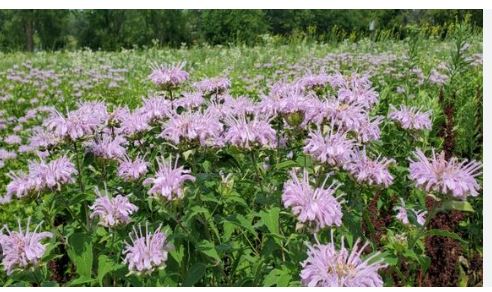
Monarda fistulosa, commonly known as Wild Bergamot or Bee Balm, is part of the Monarda genus within the Lamiaceae family, which is also known as the mint family. This species is characterized by its aromatic leaves and showy, tubular flowers that are arranged in dense, spherical clusters. The species name “fistulosa” is derived from the Latin word for “hollow or tubular,” referring to the shape of the flowers.
Wild Bergamot is native to North America, with a wide distribution across the continent. Its range extends from the eastern United States, reaching from Maine to Georgia, westward across the Great Plains to Montana, Wyoming, Colorado, and into the Canadian provinces of Manitoba, Ontario, and Quebec. It flourishes in various habitats including prairies, open woodlands, meadows, and along roadsides, preferring well-drained soils in full sun to partial shade.
Historically, Monarda fistulosa has been significant for both Native American and early European settlers in North America. Indigenous peoples used Wild Bergamot for its medicinal properties, treating ailments like colds, fevers, and digestive issues, as well as for its aromatic leaves in teas and as a flavoring. Its name “Bee Balm” reflects its attractiveness to pollinators, particularly bees. European settlers adopted these uses and further popularized the plant in gardens for its ornamental value and fragrance. It was named after Nicholas Monardes, a Spanish physician and botanist who wrote about New World plants. Over time, its use has expanded in gardening, appreciated for both its ecological benefits, attracting hummingbirds, butterflies, and bees, and its aesthetic appeal with its vibrant flower clusters.
Wild Bergamot is well-adapted to USDA Hardiness Zones 3 through 9. This broad range reflects its versatility in dealing with both cold winters and hot, humid summers, making it suitable for a large swath of North America. It prefers environments with good sun exposure but can handle some shade, particularly in hotter climates. Its ability to grow in a variety of soil conditions, although preferring well-drained soil, has made it a favorite for native plant gardens, pollinator gardens, and cottage-style landscapes where its naturalizing tendencies can be appreciated.
Wild Bergamot (Monarda fistulosa): Characteristics
- Flower Appearance: Displays showy, tubular flowers arranged in dense, spherical heads, typically lavender to pink in color, though can range from pale to deep purple.
- Bloom Time: Blooms from mid to late summer, providing a long season of interest and attracting pollinators during a time when fewer flowers might be available.
- Growth Habit: Grows as a perennial with an upright, somewhat bushy habit, reaching heights of 2 to 4 feet with a spread of 1 to 3 feet.
- Leaves: Leaves are lance-shaped, opposite, and aromatic when crushed, with a minty fragrance, often used in teas. They are toothed and have a slightly hairy texture.
- Root System: Features a fibrous root system, which allows for easy division for propagation but also means it can spread in garden settings.
- Adaptability: Quite adaptable to various soil types but prefers well-drained, loamy soils. It can thrive in full sun to partial shade, making it versatile for different garden conditions.
- Pollinator Attraction: A magnet for bees, butterflies, hummingbirds, and other pollinators, making it an excellent choice for pollinator gardens.
- Fragrance: Both the leaves and flowers are highly aromatic, with a scent reminiscent of oregano or mint, which is also a deterrent for some pests.
- Disease Susceptibility: Can be susceptible to powdery mildew, especially in humid conditions or when not given enough air circulation, though some varieties are bred for resistance.
- Ecological Role: Supports biodiversity by providing nectar and pollen for pollinators. It’s also a host plant for certain species of moths and butterflies, contributing to the life cycle of these insects.
Cultivation
- Site Selection: Choose a location with full sun to partial shade. It performs best with at least 6 hours of direct sunlight, but some afternoon shade in hotter climates can help prevent stress.
- Soil Preparation: Prefers well-drained, loamy soil but is adaptable to a range of soil types. Amend heavy soils with compost or sand to improve drainage. The soil should be moderately fertile.
- Planting: Plant in spring or fall. Space plants about 1 to 2 feet apart to allow for air circulation. For seeds, sow directly after the last frost or in fall for natural stratification.
- Watering: Water regularly until established, then reduce watering as it’s somewhat drought-tolerant. Avoid overhead watering to minimize the risk of fungal diseases like powdery mildew.
- Mulching: Apply a thin layer of mulch to retain soil moisture and suppress weeds, but keep it away from the plant’s base to allow for air circulation and prevent rot.
- Fertilization: Fertilize lightly in early spring with a balanced, slow-release fertilizer. Over-fertilizing can lead to lush growth that’s more susceptible to disease.
- Pruning and Maintenance: Deadhead spent flowers to encourage more blooms and prevent self-seeding where not desired. Cutting back after flowering can help maintain plant vigor and appearance.
- Pest and Disease Management: Monitor for powdery mildew, particularly in humid conditions. Improve air flow, water at the base, and choose mildew-resistant varieties if possible. Natural remedies like neem oil can help manage fungal issues.
- Propagation: Can be propagated by seeds, which need cold stratification, or by division in early spring or fall. Division every few years can rejuvenate older clumps.
- Winter Care: In colder zones, mulch around the base to protect the roots from freezing temperatures, though it’s quite hardy. Cut back dead foliage in late fall or early spring to tidy up the garden and promote new growth.